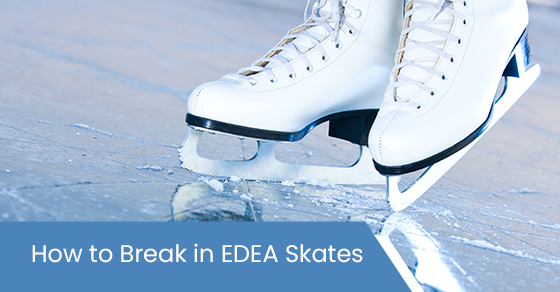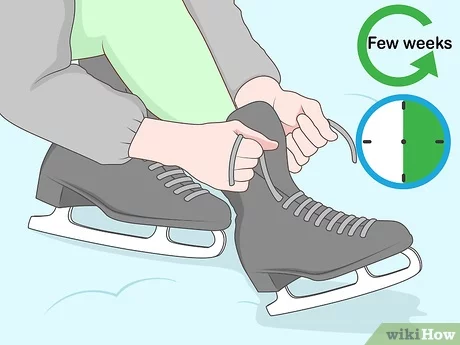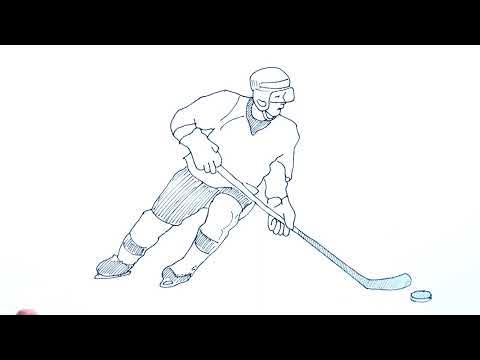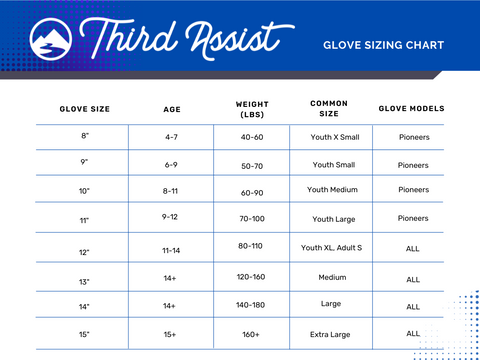Breaking in new ice hockey skates is crucial. They need to fit well for top performance and comfort.
Getting new ice hockey skates can be exciting, but they might feel stiff at first. Breaking them in properly can make a huge difference. This process ensures your skates mold to your feet, reducing pain and blisters. Properly broken-in skates improve your game by offering better control and agility on the ice.
In this guide, we’ll explore simple steps to break in your skates efficiently. Follow these tips to enjoy a more comfortable and effective skating experience. Let’s dive in!
Choosing The Right Skates
Choosing the right skates is crucial for every ice hockey player. The right pair can enhance your performance and reduce the risk of injury. Let’s dive into the key aspects of selecting the perfect skates for you.
Sizing And Fit
Proper sizing is essential for comfort and control. Ice hockey skates should fit snugly around your feet. Your toes should just brush the front of the skate. Ensure there is no extra space in the heel. This prevents your foot from sliding around.
Consider the width of your feet. Some brands offer different widths. Try on several pairs to find the best fit. Remember, skates often run smaller than regular shoes. It’s common to choose skates one to two sizes smaller than your shoe size.
Types Of Skates
There are various types of ice hockey skates available. Each type serves a different purpose. Recreational skates are great for casual players. They offer comfort and basic support.
Performance skates are designed for more serious players. These skates are stiffer and provide better support and control. They often come with advanced features, such as higher-quality steel blades.
Goalie skates are another category. These skates have a lower cut around the ankle. This design allows for greater mobility. They also have a thicker blade for stability.

Credit: www.youtube.com
Preparing Your Skates
Breaking in new ice hockey skates can be challenging. But, the right preparation can make a big difference. Properly preparing your skates ensures comfort and performance on the ice. This section will cover two essential aspects of skate preparation: heat molding and lacing techniques.
Heat Molding
Heat molding can help your skates fit better. Most modern skates are designed for this process. You can do it at home or in a pro shop. Here’s how:
First, preheat your oven to 175°F. Make sure it’s not hotter. Place your skates on a baking sheet. Insert them into the oven for 6-8 minutes. The material will soften. Remove the skates carefully. Put them on your feet immediately. Lace them up tightly. Sit still for about 15 minutes. Let the skates cool while you wear them. Avoid walking around. This helps the skates mold to your feet.
Heat molding ensures a custom fit. It reduces the break-in period. Always follow the manufacturer’s guidelines. Some materials may vary.
Lacing Techniques
Correct lacing techniques can improve your skate fit. It also enhances your control on the ice. Start with the toe area. Lace tightly, but not too tight. Your toes need some room to move. Move up to the midsection. Here, pull the laces snugly. This locks your heel in place. Finally, focus on the top section. Tighten the laces for firm ankle support. Tie a secure knot. Double knots work best.
Experiment with different lacing patterns. Some skaters prefer crisscross lacing. Others use over-under lacing. Find what feels best for you. Proper lacing prevents blisters and pain. It ensures you have a comfortable skating experience.
Wearing Your Skates
Breaking in ice hockey skates is vital for comfort and performance. It helps prevent blisters and ensures a perfect fit. This process involves wearing your skates properly and gradually increasing their use. Let’s dive into the details.
Initial Wear At Home
Start by wearing your skates at home. Put them on and lace them up snugly. Walk around your living room or any carpeted area. This helps the skates mold to your feet.
Wear them for short periods, around 15-20 minutes. Do this a few times a day. This step helps soften the stiff materials. It also reduces discomfort during your first on-ice session.
Gradual Increase In Use
After a few days of wearing your skates at home, it’s time to hit the rink. Begin with short skating sessions. Keep the first few sessions under 30 minutes. Your feet need time to adjust to the new skates.
Increase the duration gradually. Move up to longer sessions as your comfort level improves. Pay attention to any pain points. If you feel discomfort, adjust the laces or take short breaks.
Remember, patience is key. The break-in process can take a few weeks. But, the effort ensures a perfect fit and optimal performance on the ice.
On-ice Break-in Methods
Breaking in new ice hockey skates can be a challenging task. Proper methods ensure the skates fit comfortably and perform well on the ice. On-ice break-in methods are effective and help you get used to your new skates quickly. Let’s explore some helpful techniques.
First Skating Sessions
Wear your new skates during a few short skating sessions. Keep these sessions to 15-20 minutes each. This helps your feet adjust to the new skates. Avoid intense activities or games during these first sessions. Focus on gentle skating to break in the skates gradually.
Drills And Exercises
Incorporate specific drills and exercises during your break-in period. Practice basic skating moves like forward skating, backward skating, and crossovers. These movements help mold the skates to your feet. Try edge work drills to improve comfort and performance. Edge work includes inside and outside edge drills. This will further help in breaking in your skates effectively.
Remember to listen to your body. If you feel discomfort, take a break. Gradual break-in avoids pain and blisters. Properly breaking in your skates will improve your skating experience. Happy skating!
Dealing With Discomfort
Breaking in new ice hockey skates can be a painful process. Your feet need time to adjust to the new fit. Discomfort is common during this period. But there are ways to manage and reduce it.
Common Pressure Points
Most players experience pain in certain areas. These are known as pressure points. Common pressure points include the toes, arches, and ankles. The stiff material of new skates can cause these areas to hurt.
Blisters often form on the heels. Tight laces can also cause pain on the top of the foot. Knowing these areas helps you address the discomfort better.
Pain Relief Tips
There are several ways to ease the pain. Wear thick, moisture-wicking socks to reduce friction. Use gel pads or moleskin on high-pressure areas. These create a cushion and lessen pain.
Loosen the laces in the painful areas. This can reduce pressure on your feet. Take breaks often to give your feet a rest. Ice packs can help reduce swelling and numb the pain.
Consider professional skate stretching services. This can help mold the skates to your feet better. Remember, the discomfort is temporary. Soon, your skates will fit perfectly.
Maintaining Your Skates
Proper maintenance of ice hockey skates is crucial for performance. Regular care ensures longevity and optimal performance. Below are some key steps for maintaining your skates.
Regular Inspections
Inspect your skates before and after each use. Look for any visible damage. Check the blades for nicks or dull spots. Ensure the boot is not cracked or worn. Replace worn-out laces promptly. Tighten loose screws and rivets. Regular inspections can prevent bigger issues.
Sharpening And Repairs
Sharpen your skates regularly. Dull blades affect performance and safety. Most players sharpen their skates after 8-10 hours of use. Visit a professional for sharpening. DIY sharpening can damage blades.
Repair any damage promptly. Small issues can become big problems. Fix cracks in the boot immediately. Replace worn-out padding. Proper repairs keep your skates in good condition.
Use the table below for a quick reference on maintenance tasks:
| Task | Frequency | Notes |
|---|---|---|
| Inspect Blades | Before/After Each Use | Look for nicks and dull spots |
| Sharpen Blades | Every 8-10 Hours of Use | Visit a professional |
| Check Laces | Regularly | Replace if worn |
| Repair Boot Damage | As Needed | Fix cracks immediately |
Maintain your skates well. They will serve you better on the ice.
Enhancing Skate Comfort
Breaking in ice hockey skates is crucial for performance. Enhancing skate comfort ensures a better fit and reduces foot pain. This section covers insoles, padding, socks, and footwear.
Insoles And Padding
Insoles provide additional support inside the skate. Custom insoles can be molded to your foot shape. This helps reduce pressure points and improves comfort. Look for insoles that offer good arch support. Thicker padding around the ankles can prevent blisters. Make sure padding is snug but not too tight.
Socks And Footwear
Wearing the right socks is vital. Thin, moisture-wicking socks work best. Avoid thick socks as they can cause bunching. Proper socks help keep feet dry and reduce friction. Footwear before and after skating also matters. Wear comfortable, supportive shoes to prevent foot strain. This helps your feet recover faster.

Credit: m.youtube.com
Expert Advice And Insights
Breaking in ice hockey skates can be challenging. Many players face discomfort and blisters. Expert advice can make this process smoother. This section shares tips from professionals and common mistakes to avoid.
Professional Skater Tips
Professional skaters have a wealth of experience. Their tips can help you break in your skates faster and more comfortably. Here are a few key pieces of advice:
- Wear your skates at home: Walk around the house. This helps mold the skates to your feet.
- Use skate guards: Protect your blades and increase stability while walking.
- Bake your skates: Many pro shops offer baking services. Heat molds the skates to your feet.
- Wear thick socks: This reduces friction and prevents blisters.
- Practice on the ice: Spend time on the ice. Skate slowly to let your feet adjust.
Common Mistakes To Avoid
Many players make mistakes while breaking in skates. Avoid these common pitfalls to ensure a better experience:
- Skipping the break-in period: Don’t rush. Wear your skates for short periods initially.
- Using thin socks: Thin socks increase friction and cause blisters.
- Tightening laces too much: Over-tightening can cause foot pain and poor circulation.
- Not using skate guards: Walking without guards can damage the blades.
- Ignoring hot spots: Address discomfort immediately. Use padding or adjust laces.
Follow these expert tips and avoid common mistakes. You’ll break in your skates more effectively and enjoy your time on the ice.

Credit: skatingboutique.com
Frequently Asked Questions
How Long To Break In Hockey Skates?
Breaking in hockey skates typically takes 5-10 hours of ice time. Consistency is key. Wear them during practice sessions to ensure they mold to your feet properly.
How To Make Hockey Skates More Comfortable?
To make hockey skates more comfortable, wear them around the house. Use skate guards to protect the blades. Heat molding can also help achieve a better fit.
Can You Bake Hockey Skates At Home?
Yes, you can bake hockey skates at home. Use an oven specifically designed for skates. Follow manufacturer instructions carefully to avoid damage.
What Socks To Wear With New Hockey Skates?
Wear thin, moisture-wicking socks with new hockey skates. They help reduce friction and blisters. Avoid thick socks, which can alter the fit and comfort.
Conclusion
Breaking in your ice hockey skates takes patience and effort. Properly fitted skates improve your game. Follow the tips for faster and more comfortable break-in. Wear them at home, or try skating indoors first. Gradually increase your time on the ice.
Always dry your skates after use. Comfortable skates help you play better and avoid injuries. Keep practicing and enjoy your time on the rink. Happy skating!



